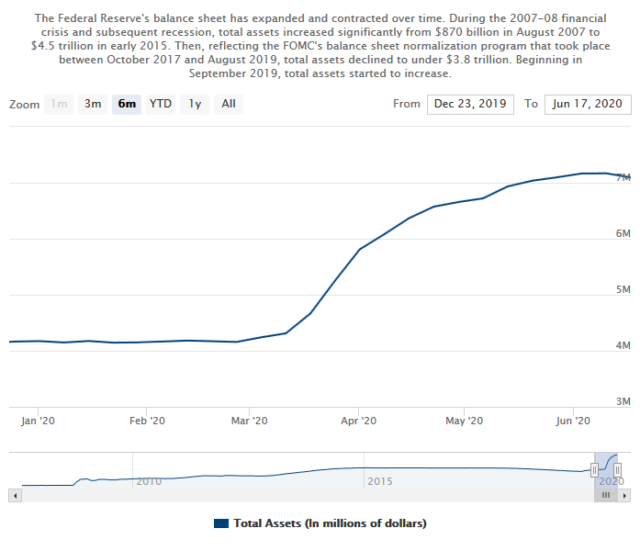The federal reserve’s balance sheet is telling of where monetary policy is going:
(You can view the longer term chart here)
It peaked on June 10th and the next week’s update (June 17th) showed a minor contraction.
From the last interest rate announcement, we had the following implementation note:
* Increase the System Open Market Account holdings of Treasury securities, agency mortgage-backed securities (MBS), and agency commercial mortgage-backed securities (CMBS) at least at the current pace to sustain smooth functioning of markets for these securities, thereby fostering effective transmission of monetary policy to broader financial conditions.
* Conduct term and overnight repurchase agreement operations to support effective policy implementation and the smooth functioning of short-term U.S. dollar funding markets.
* Conduct overnight reverse repurchase agreement operations at an offering rate of 0.00 percent and with a per-counterparty limit of $30 billion per day; the per-counterparty limit can be temporarily increased at the discretion of the Chair.
* Roll over at auction all principal payments from the Federal Reserve’s holdings of Treasury securities and reinvest all principal payments from the Federal Reserve’s holdings of agency debt and agency MBS in agency MBS and all principal payments from holdings of agency CMBS in agency CMBS.
Things are continuing, but monetary injection is not going to be the rocket ship that it was. The 3 trillion dollars of liquidity thrown into the system will have to take its time to transmit into the real economy (if indeed, it does at all).
I will point out that during the 2008-2009 economic crisis, essentially the same response was there – the primary liquidity injection was done in the 4th quarter of 2008, but it took some time from 2009 onwards in order for stock prices to really jump up. All analogies have different variables at play, and this is most certainly not the 2008-2009 economic crisis (nor the great depression) so again, the playbook here is going to be quite different.
I’ll also point out that the Bank of Canada is getting into the business of inflating its own balance sheet, albeit not nearly at the pace that the Federal Reserve has (even adjusting for the relative sizes of the countries).
